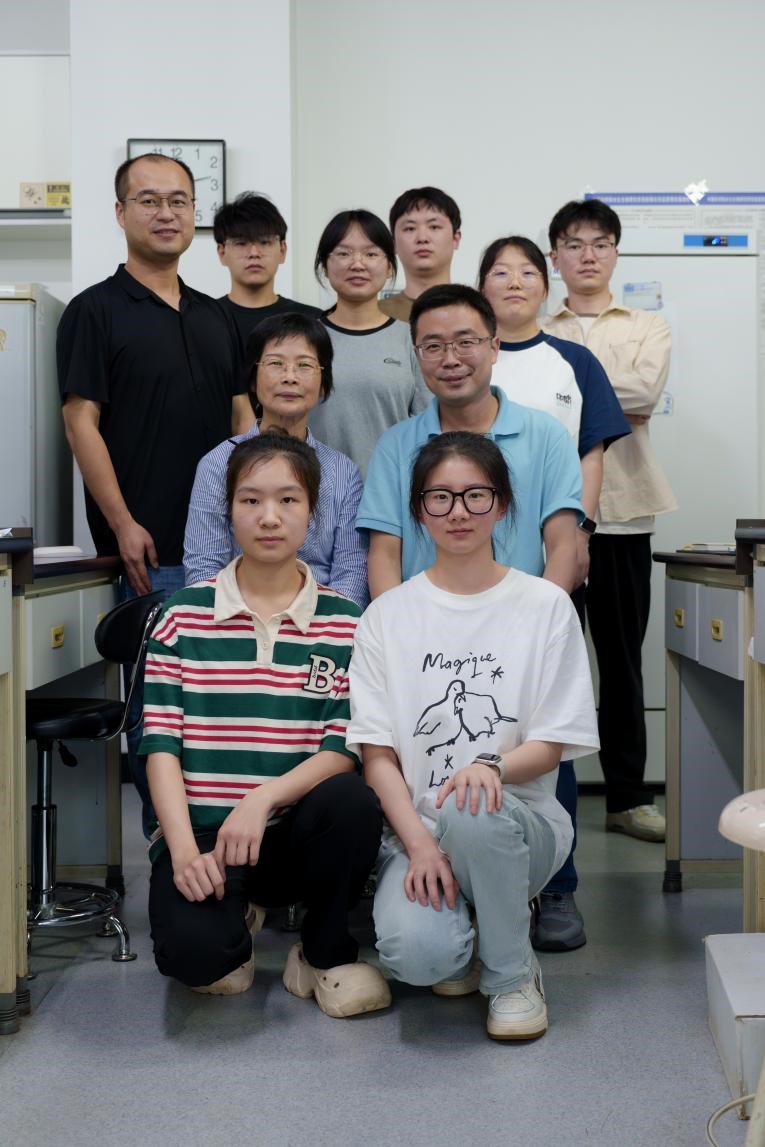
Centers
Research Group on Aquatic Virology

Group Members:
Fei KE (PhD/Associate Professor)
Qi-Ya ZHANG (PhD / Professor)
Bo LIANG (PhD/Postdoctor)
Graduate student: Yu-Han CHEN, Xiao QIN, Bo-Qian CHEN, An-Kun LIU, Yi KANG, Meng-Jing ZENG, Yu ZHOU
Visiting student: Yan-Lin CHEN
General Introduction:
The Aquatic Virology Research Group is highly focused on the study of aquatic animal viruses that cause epidemic diseases and aquatic microbial viruses that drive the Earth's biogeochemical cycles at the nanoscale. For over 20 years, under the leadership of Prof. Zhang Qi-Ya and the joint efforts of the team members, they have been deeply engaged in research on the isolation and identification of aquatic viral pathogens, the structural characteristics of viral genomes and the function of key genes, viral replication, genetic evolution, interactions between viruses and their hosts and aquatic environments, and detection and prevention technologies for aquatic viral diseases. Based on the construction of an aquatic virology research technical system, various viral pathogens have been identified from sick amphibians, fish, and crustaceans, as well as from harmful algae; the full genomes of more than ten types of aquatic viruses from six families have been deciphered; the structural characteristics and biological functions of key genes of a batch of aquatic viruses have been clarified; and the molecular mechanisms of frog virus pathogenicity and cross-species infection replication have been revealed. The group has won two Hubei Provincial Natural Science Awards.
In the future, the research group will continue to adhere to the study of aquatic viruses and their molecular biology, focusing on the mechanisms of invasion and infection by emerging and re-emerging aquatic viruses, as well as the replication and transcription mechanisms of their genomes. They aim to explore how aquatic viruses infect different hosts, in order to elucidate the mechanisms of aquatic viral infection and cross-species transmission, and to find methods to resist viral diseases or to utilize viral biological resources.
Major Areas of Research:
1. Isolation and identification of emerging and re-emerging aquatic viral pathogens.
2. Elucidation of aquatic virus life cycle, pathogenesis and evolution, and the interaction of viruses and their hosts in aquatic environment.
3. Development of the strategies for preventing, diagnosing and controlling viral diseases in aquaculture, and exploration of aquatic virus resources.
Current Topics:
1. Genomic replication and transcription, pathogenesis and transmission of viral pathogens in important aquatic animals (crucian carp, grass carp, mandarin fish, etc.), as well as the molecular mechanisms of interaction between these viruses and hosts.
2. Interactions between cyanophages and their hosts.
3. New technologies in aquatic virus research.
Contact Us:
Email: kefei@ihb.ac.cn
Awarded Achievements:
1. Genome anatomy of different aquatic animal viruses and molecular mechanism of virus-host interactions, Second grade prize of natural science of Hubei province, 2017.
2. Identification of important viral pathogens from aquaculture animals and mechanisms of their pathogenesis, Second grade prize of natural science of Hubei province, 2004.
Representative Publications:
Jiang QQ, Li Z, Zhang QY, Ke F. A novel cell line established from skin tissue of gibel carp (Carassius gibelio) is susceptible to Carassius auratus herpesvirus infection. Water Biology and Security 2024, 3: 100253.
Meng XY, Jiang QQ, Yu XD, Zhang QY, Ke F. Eukaryotic translation elongation factor 1 alpha (eEF1A) inhibits Siniperca chuatsi rhabdovirus (SCRV) infection through two distinct mechanisms. J Virol. 2023, 97: e0122623.
Ke F, Zhang QY. Advances on genomes studies of large DNA viruses in aquaculture: A minireview. Genomics. 2023, 115:110720.
Jiang QQ, Meng XY, Yu XD, Zhang QY, Ke F. Fusing a TurboID tag with the Andrias davidianus ranavirus 2L reduced virus adsorption efficiency. Microb Pathog. 2023, 182: 106220.
Yu XD, Ke F, Zhang QY, Gui JF. Genome characteristics of two ranavirus isolates from mandarin fish and largemouth bass. Pathogens. 2023, 12: 730.
Meng LH, Ke F, Zhang QY, Zhao Z. Biological and genomic characteristics of MaMV-DH01, a novel freshwater Myoviridae cyanophage strain. Microbiol Spectr. 2023,11: e0288822.
Ke F, Yu XD, Wang ZH, Gui JF, Zhang QY. Replication and transcription machinery for ranaviruses: components, correlation, and functional architecture. Cell Biosci. 2022, 12: 6.
Ke F, Zhang QY. ADRV 12L: A ranaviral putative Rad2 family protein involved in DNA recombination and repair. Viruses. 2022, 14: 908.
Ke F, Wang RB, Wang ZH, Zhang QY. Andrias davidianus ranavirus (ADRV) genome replicate efficiently by engaging cellular mismatch repair protein MSH2. Viruses. 2022,14: 952.
Ke F, Meng XY, Zhang QY. Siniperca chuatsi rhabdovirus (SCRV)-induced key pathways and major antiviral genes in fish cells. Microorganisms 2022, 10: 2464.
Meng XY, Wang ZH, Yu XD, Zhang QY, Ke F. Development and characterization of a skin cell line from Chinese perch (Siniperca chuatsi) and its application in aquatic animal viruses. J Fish Dis. 2022, 45:1439-1449.
Wang ZH, Ke F, Gui JF, Zhang QY. Environmental factors and their threshold affecting the survival of five aquatic animal viruses in different animal cells. Viruses. 2022, 14:2546.
Zhang QY, Ke F, Gui L, Zhao Z, Recent insights into aquatic viruses: Emerging and reemerging pathogens, molecular features, biological effects, and novel investigative approaches. Water Biology and Security 2022, 1: 100062.
Wang ZH, Ke F, Zhang QY, Gui JF. Structural and functional diversity among five RING finger proteins from Carassius auratus herpesvirus (CaHV). Viruses. 2021, 13: 254.
Ke F#, Gui L#, Li T, Li FH, Zhao X, Chen ZY, Lei CK, Zhang QY. The features of an emerging whispovirus isolate from freshwater crayfish. Aquaculture Reports. 2021, 20: 100728.
Zhao YH, Zeng XT, Zhang QY. Fish herpesvirus protein (CaHV-138L) can target to mitochondrial protein FoF1 ATPase. Virus Res. 2020, 275:197754.
Yu NT, Ke F, Zhang QY. Andrias davidianus ranavirus 1R encoding a delayed-early protein promotes cell proliferation by driving cell cycle progression into S phase. Acta Virol. 2020, 64:10-19.
Ke F, Wang ZH, Ming CY, Zhang QY. Ranaviruses bind cells from different species through interaction with Heparan Sulfate. Viruses. 2019, 11. pii: E593.
Ke F, Zhang QY. Aquatic animal viruses mediated immune evasion in their host. Fish Shellfish Immunol. 2019, 86:1096-1105.
Li T, Ke F, Gui JF, Zhou L, Zhang XJ, Zhang QY. Protective effect of Clostridium butyricum against Carassius auratus herpesvirus in gibel carp. Aquaculture International. 2019, 27(3): 905-914.
Ke F, Gui JF, Chen ZY, Li T, Lei CK, Wang ZH, Zhang QY. Divergent transcriptomic responses underlying the ranaviruses-amphibian interaction processes on interspecies infection of Chinese giant salamander. BMC Genomics. 2018, 19: 211.
Chen ZY, Li T, Gao XC, Wang CF, Zhang QY. Protective Immunity Induced by DNA Vaccination against Ranavirus Infection in Chinese Giant Salamander Andrias davidianus. Viruses. 2018, 10. pii: E52.
Cao YS , Wang D, Li SW, Xu LM, Zhao JZ, Liu HB, Lu TY, Zhang QY. Identification and analysis of differentially expressed microRNAs in rainbow trout (Oncorhynchus mykiss) responding to infectious hematopoietic necrosis virus infection. Developmental and Comparative Immunology. 2018, 88: 28-36.
Gui L, Chinchar VG, Zhang QY. Molecular basis of pathogenesis of emerging viruses infecting aquatic animals. Aquaculture and Fisheries. 2018, 3: 1-5.
Gui L, Li T, Zhang QY. Fish kidney cells show higher tolerance to hyperosmolality than amphibian. Aquaculture and Fisheries. 2018, 3: 135-138.
Chinchar VG, Hick P, Ince IA, Jancovich JK, Marschang R, Qin Q, Subramaniam K, Waltzek TB, Whittington R, Williams T, Zhang QY, Ictv Report Consortium. 2017. ICTV Virus Taxonomy Profile: Iridoviridae. Journal of General Virology. 98: 890-891.
Zhang QY, Gui JF. 2015. Virus genomes and virus-host interactions in aquaculture animals. Sci China Life Sci. 58: 156-169.